Friday, January 08, 2021
Lukyanov's water computer
The Russians made the most interesting analog computers. They stuck with analog cybernetics long after Westerners had switched to digital.
In 1936 Lukyanov developed a water-based computer to solve complicated functions for engineering and construction. He was working primarily with concrete and soil under freezing conditions, trying to help design dams and pavement in cold places. His machine, and later variants, served many purposes into the 1970s.
I've drawn the 'museum version' of Lukyanov's hydrointegrator. This may have been only the control panel; it diverges from his descriptions of the functional machine. The real machine was modular, with several large blocks of pipes and tubes behind the control panel.
This picture seems to show the real machine in use:
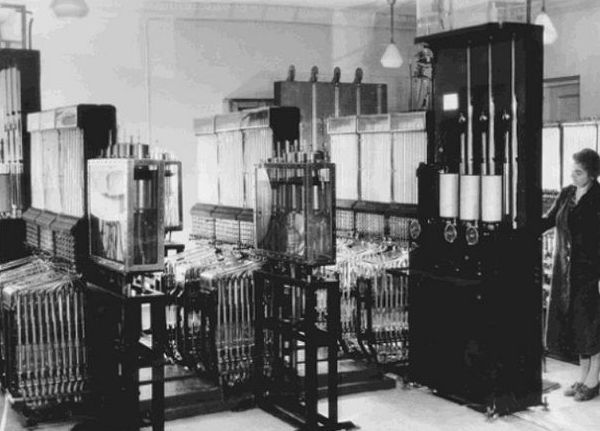 And this diagram is similar, with the plots showing up more clearly:
And this diagram is similar, with the plots showing up more clearly:
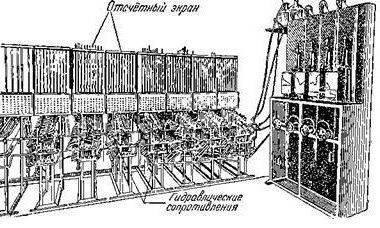 The cylinders holding graphic plots would normally be plotted outputs, but in this machine they're inputs. The real machine had four optional input variables, along with an implicit time variable.
A typical use was modeling heat transfer through a structure (dam or pavement) treated as a series of layers. Each water column represented a layer, and each column could be programmed to let in water at a specific rate. In other words, each column was like an RC filter in a sequential filter setup, with the visible height (or voltage in the electronic version) representing the temperature in that layer of the dam.
The cylinders holding graphic plots would normally be plotted outputs, but in this machine they're inputs. The real machine had four optional input variables, along with an implicit time variable.
A typical use was modeling heat transfer through a structure (dam or pavement) treated as a series of layers. Each water column represented a layer, and each column could be programmed to let in water at a specific rate. In other words, each column was like an RC filter in a sequential filter setup, with the visible height (or voltage in the electronic version) representing the temperature in that layer of the dam.
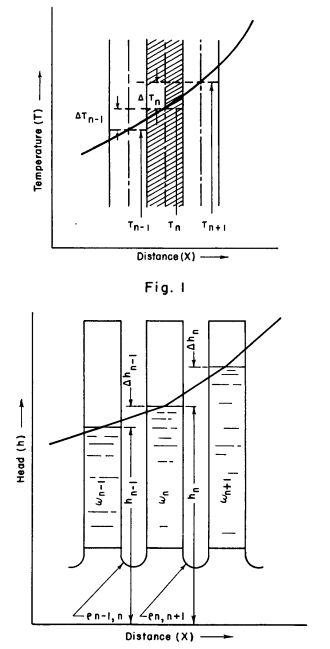 These diagrams clearly show the primary advantage of analog systems, whether mechanical or fluid or electronic, over digital software. In real life each layer or module or neuron or organism is always continuously influencing all other layers, with influence and feedback in all directions at once. Interconnected water columns do it naturally. You can't do it at all with interconnected functions in software. You can pass differences from subroutine A to subroutine B, and pass results back, but there's no way to make the influences simultaneous and continuous.
Electronic version:
These diagrams clearly show the primary advantage of analog systems, whether mechanical or fluid or electronic, over digital software. In real life each layer or module or neuron or organism is always continuously influencing all other layers, with influence and feedback in all directions at once. Interconnected water columns do it naturally. You can't do it at all with interconnected functions in software. You can pass differences from subroutine A to subroutine B, and pass results back, but there's no way to make the influences simultaneous and continuous.
Electronic version:
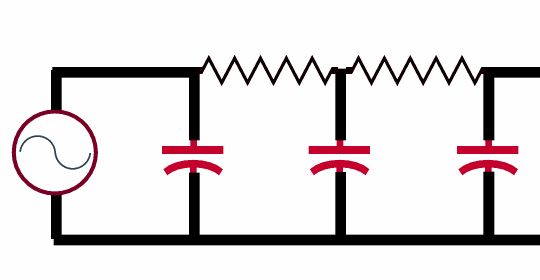 The operator used the big lever to follow the curve already drawn on the wrapped graph. As the lever moved up and down, it moved a tank up and down, raising and lowering the 'potential voltage' input to the system. This diagram shows two input variables B1 and B2.
The operator used the big lever to follow the curve already drawn on the wrapped graph. As the lever moved up and down, it moved a tank up and down, raising and lowering the 'potential voltage' input to the system. This diagram shows two input variables B1 and B2.
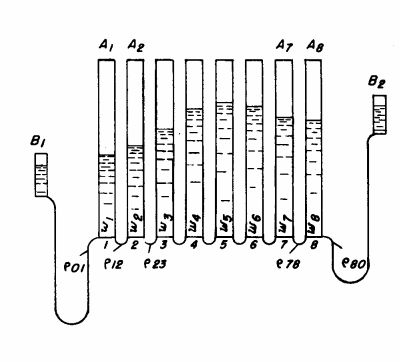 Programs were entered on the three rows of valves in the center of the control panel. The description doesn't clarify the specific purpose of each row, and the upper crank is also unclear. I suspect it was a manual turner or winder for the plot cylinder, which was apparently driven by clockwork.
Programs were entered on the three rows of valves in the center of the control panel. The description doesn't clarify the specific purpose of each row, and the upper crank is also unclear. I suspect it was a manual turner or winder for the plot cylinder, which was apparently driven by clockwork.
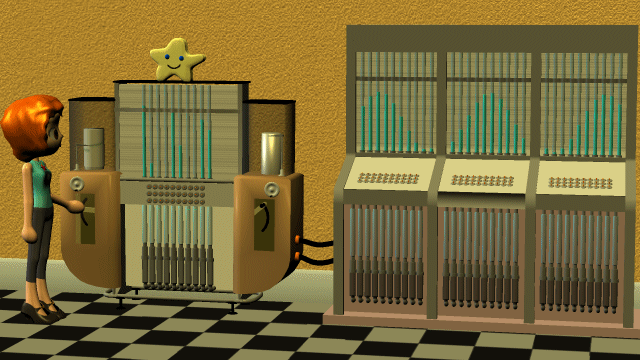 Here Polistra is moving the big lever to follow the dam plot on the left cylinder, and the tubes are responding with a (purely imagined) output pattern. Another observer would record the heights at different times, or perhaps use a mounted movie camera to make a direct record.
The RC-like effect of the flow would also enable a single transient response to be modeled. After setting the valves for the appropriate pattern of Rs and Cs, just yank the lever upward and watch the columns move for a minute or two.
= = = = =
Footnote: The best descriptions in English are here at Archive.org.
= = = = =
Sidenote after thinking about "devices" and Pied Pipers: another advantage of mechanical and fluidic computers is independence. They can't be hacked or detected from a distance. Only a live spy in the same room can control or read them. Even electronic analogs are harder to penetrate than digital, because they don't emit a readable stream of patterned codes. An RC computer responds when you turn the knobs, then settles gradually into a new condition. No predictable and redundant patterns. Russia understood this point deeply after repeated invasions and penetrations by Krauts and Yanks.
Here Polistra is moving the big lever to follow the dam plot on the left cylinder, and the tubes are responding with a (purely imagined) output pattern. Another observer would record the heights at different times, or perhaps use a mounted movie camera to make a direct record.
The RC-like effect of the flow would also enable a single transient response to be modeled. After setting the valves for the appropriate pattern of Rs and Cs, just yank the lever upward and watch the columns move for a minute or two.
= = = = =
Footnote: The best descriptions in English are here at Archive.org.
= = = = =
Sidenote after thinking about "devices" and Pied Pipers: another advantage of mechanical and fluidic computers is independence. They can't be hacked or detected from a distance. Only a live spy in the same room can control or read them. Even electronic analogs are harder to penetrate than digital, because they don't emit a readable stream of patterned codes. An RC computer responds when you turn the knobs, then settles gradually into a new condition. No predictable and redundant patterns. Russia understood this point deeply after repeated invasions and penetrations by Krauts and Yanks.
 And this diagram is similar, with the plots showing up more clearly:
And this diagram is similar, with the plots showing up more clearly:
 The cylinders holding graphic plots would normally be plotted outputs, but in this machine they're inputs. The real machine had four optional input variables, along with an implicit time variable.
A typical use was modeling heat transfer through a structure (dam or pavement) treated as a series of layers. Each water column represented a layer, and each column could be programmed to let in water at a specific rate. In other words, each column was like an RC filter in a sequential filter setup, with the visible height (or voltage in the electronic version) representing the temperature in that layer of the dam.
The cylinders holding graphic plots would normally be plotted outputs, but in this machine they're inputs. The real machine had four optional input variables, along with an implicit time variable.
A typical use was modeling heat transfer through a structure (dam or pavement) treated as a series of layers. Each water column represented a layer, and each column could be programmed to let in water at a specific rate. In other words, each column was like an RC filter in a sequential filter setup, with the visible height (or voltage in the electronic version) representing the temperature in that layer of the dam.
 These diagrams clearly show the primary advantage of analog systems, whether mechanical or fluid or electronic, over digital software. In real life each layer or module or neuron or organism is always continuously influencing all other layers, with influence and feedback in all directions at once. Interconnected water columns do it naturally. You can't do it at all with interconnected functions in software. You can pass differences from subroutine A to subroutine B, and pass results back, but there's no way to make the influences simultaneous and continuous.
Electronic version:
These diagrams clearly show the primary advantage of analog systems, whether mechanical or fluid or electronic, over digital software. In real life each layer or module or neuron or organism is always continuously influencing all other layers, with influence and feedback in all directions at once. Interconnected water columns do it naturally. You can't do it at all with interconnected functions in software. You can pass differences from subroutine A to subroutine B, and pass results back, but there's no way to make the influences simultaneous and continuous.
Electronic version:
 The operator used the big lever to follow the curve already drawn on the wrapped graph. As the lever moved up and down, it moved a tank up and down, raising and lowering the 'potential voltage' input to the system. This diagram shows two input variables B1 and B2.
The operator used the big lever to follow the curve already drawn on the wrapped graph. As the lever moved up and down, it moved a tank up and down, raising and lowering the 'potential voltage' input to the system. This diagram shows two input variables B1 and B2.
 Programs were entered on the three rows of valves in the center of the control panel. The description doesn't clarify the specific purpose of each row, and the upper crank is also unclear. I suspect it was a manual turner or winder for the plot cylinder, which was apparently driven by clockwork.
Programs were entered on the three rows of valves in the center of the control panel. The description doesn't clarify the specific purpose of each row, and the upper crank is also unclear. I suspect it was a manual turner or winder for the plot cylinder, which was apparently driven by clockwork.
 Here Polistra is moving the big lever to follow the dam plot on the left cylinder, and the tubes are responding with a (purely imagined) output pattern. Another observer would record the heights at different times, or perhaps use a mounted movie camera to make a direct record.
The RC-like effect of the flow would also enable a single transient response to be modeled. After setting the valves for the appropriate pattern of Rs and Cs, just yank the lever upward and watch the columns move for a minute or two.
= = = = =
Footnote: The best descriptions in English are here at Archive.org.
= = = = =
Sidenote after thinking about "devices" and Pied Pipers: another advantage of mechanical and fluidic computers is independence. They can't be hacked or detected from a distance. Only a live spy in the same room can control or read them. Even electronic analogs are harder to penetrate than digital, because they don't emit a readable stream of patterned codes. An RC computer responds when you turn the knobs, then settles gradually into a new condition. No predictable and redundant patterns. Russia understood this point deeply after repeated invasions and penetrations by Krauts and Yanks.
Here Polistra is moving the big lever to follow the dam plot on the left cylinder, and the tubes are responding with a (purely imagined) output pattern. Another observer would record the heights at different times, or perhaps use a mounted movie camera to make a direct record.
The RC-like effect of the flow would also enable a single transient response to be modeled. After setting the valves for the appropriate pattern of Rs and Cs, just yank the lever upward and watch the columns move for a minute or two.
= = = = =
Footnote: The best descriptions in English are here at Archive.org.
= = = = =
Sidenote after thinking about "devices" and Pied Pipers: another advantage of mechanical and fluidic computers is independence. They can't be hacked or detected from a distance. Only a live spy in the same room can control or read them. Even electronic analogs are harder to penetrate than digital, because they don't emit a readable stream of patterned codes. An RC computer responds when you turn the knobs, then settles gradually into a new condition. No predictable and redundant patterns. Russia understood this point deeply after repeated invasions and penetrations by Krauts and Yanks.Labels: Natural law = Soviet law, Patient things
